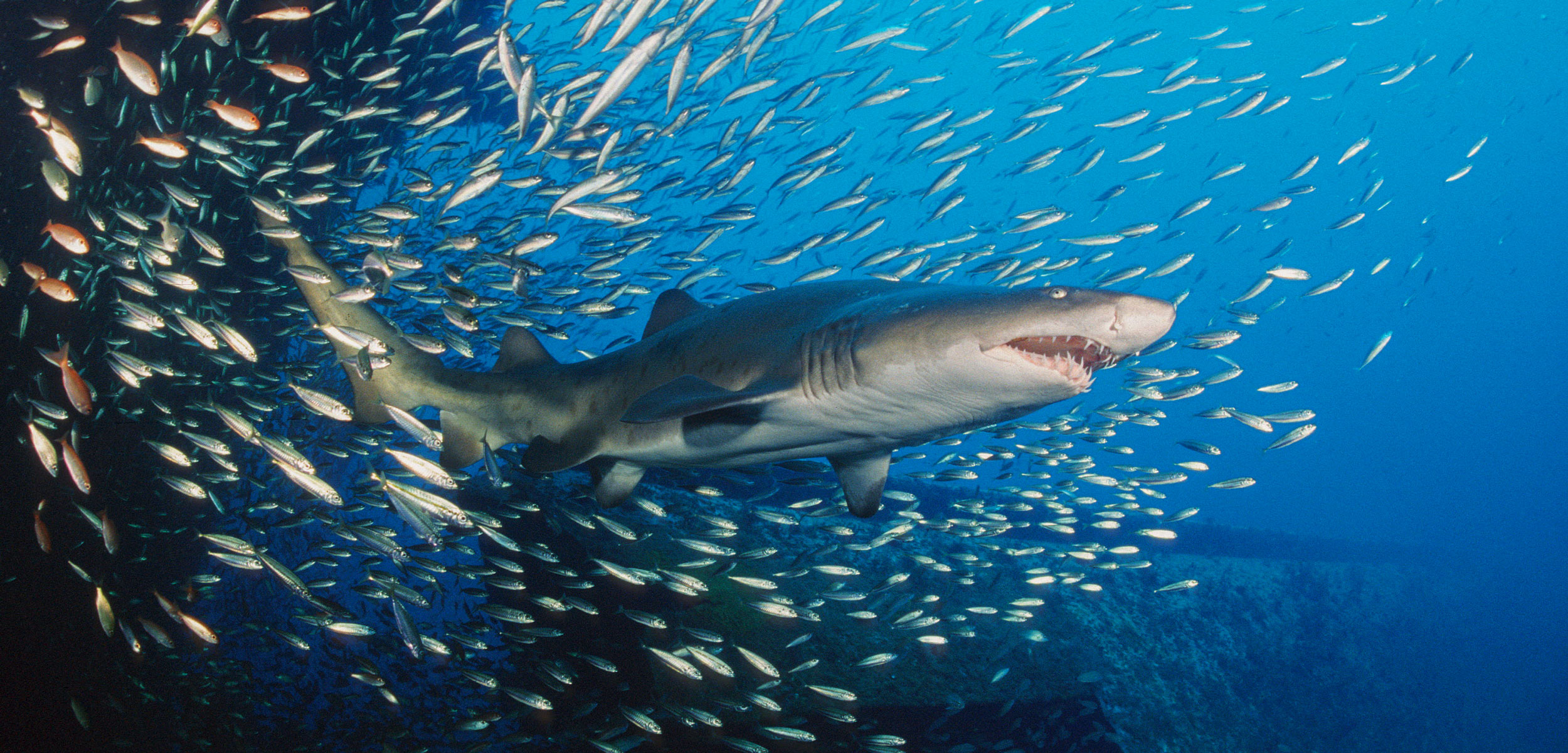Watch Out for Camouflaged Sharks
Sneaky sand tiger sharks prove the old adage true—there is always a bigger fish.
Article body copy
A hungry almaco jack cruises through the water, light glinting off its meter-long yellow-striped flanks. The fish’s black-banded eyes are tracking a school of hand-sized round scad. Alert to the threat, the scad make a run—fleeing straight into the path of a sand tiger shark, its maw bristling with teeth. Though they could easily be gobbled whole, the tiny fish hold tight, encircling the massive shark. The bold almaco jack charges, seemingly unaware of the danger concealed in the swirling throng of shining silver, and the scene erupts as the sand tiger shark lunges.
This unlikely example of interspecies deceit is one of several documented in a new study by Erin Burge, an ecologist at Coastal Carolina University in South Carolina, which shows how in the presence of mesopredators such as almaco jack, schools of round scad routinely flock to sand tiger sharks for protection.
Burge initially noticed sharks hiding among scad in the early 2000s while diving off the North Carolina coast. The unusual sight sparked a question in his mind: why would something that could be eaten by a shark hang out with a shark? Years later, Burge finally had a way to answer that question.
Analyzing hours of video of sand tiger sharks and round scad filmed by the publicly viewable Shark Cam, which is located 50 kilometers off North Carolina, Burge and Coastal Carolina University student Nick Coleman show in the study that not only do round scad swim to sand tiger sharks for protection, sand tiger sharks are keen to use the cloud of scad as cover to launch predation attempts on the offending mesopredators. These camouflaged attacks are rare—the scientists only saw five in more than 340 hours of video—and largely unsuccessful. But in at least one instance, the shark snagged an easy meal.
A sand tiger shark, concealed by round scad, launches an undercover attack. Video courtesy of Erin Burge/Shark Cam
Carol Price, a conservation biologist for the North Carolina Aquariums and the lead scientist for Spot a Shark, a project that tracks sand tiger sharks using submitted photos and videos, says she’s seen the first half of this relationship often—scad swarming sand tiger sharks—but never the shark’s subsequent attack.
Sand tiger sharks, says Price, who was not involved in the study, are indiscriminate eaters—they’ll happily take rays, skates, tuna, smaller bony fish, and even crustaceans. Despite this, Price stresses that any observations of sand tiger sharks feeding are exceedingly rare. There have been no predation attempts in any of the videos and photographs submitted to Spot a Shark.
She’s not at all surprised, though, that sand tiger sharks would take an opportunity to grab a meal. “You know when you’re not hungry at all, and then you’re at a buffet,” says Price, “and there are deviled eggs and you’re like, Oh I’m going to have those deviled eggs.”
Seeing sand tiger sharks hunt is rare, but seeing them hunt from within obscuring scad is even more so. The three-way scad-mesopredator-shark dynamic, says Burge, is an example of a behaviorally mediated indirect interaction (BMII)—that is, when an initial species changes the behavior of a second, which then impacts a third. BMIIs can be difficult to study, Burge says, because even the presence of an observing scientist is likely to disrupt the interaction.
This “really unique opportunity to remove an observer,” says Burge, eventually yielded the rarest sight of all: a successful predation attempt. At the end of a five-hour-long feeding event in December featuring scad-shark teamwork, a sand tiger shark finally caught a fish on camera. “It was just so exciting,” says Burge.
As the mesopredators in North Carolina’s waters know, what matters is not the size of your opponent, but that of your biggest friend. Luckily for round scad, their friend is pretty big.

